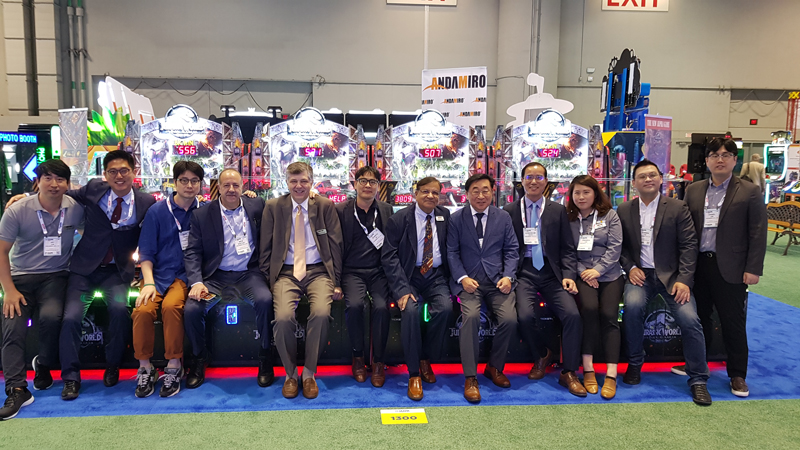Satinder Bhutani retires from Andamiro USA, capping a vibrant coin-op career spanning 4 decades

Satinder Bhutani is retiring from his post at Andamiro USA Corp., where he spent the past two decades of a distinguished 38-year career in the amusement machine industry. He joined Andamiro USA in 2001 and became its president in 2010. While many industry sales leaders amassed résumés with employment listings at almost a dozen factories, Bhutani has worked for only three companies during his livelihood.
Before ascending to the top position of what would become one of the most recognizable companies in the amusement industry, Bhutani learned the coin-op business during the heyday of pinball machines and videogames. “My introduction to the coin-op industry was through my brother Satish, an industry legend in his own right,” Bhutani said.
Born in India, where he studied chemistry, physics and mathematics, earning a master’s in statistics at Meerut University, Bhutani had a promising sales career with Mumbai-based Larsen & Toubro Ltd. A global giant in technology, engineering, construction, manufacturing and financial services, L&T had revenues of $20 billion in 2019. But a sense of adventure inspired him to leave the familiarity of his homeland in search of new opportunities. In 1981, Bhutani left India for the United States with his wife, Meena, and mother, Lila Wati. They landed in San Francisco on May 13, and California would remain their home. Their son Sameer was born in the U.S.
Bhutani soon joined Bhuzac International Inc. in Foster City. Established by his older brother, Bhuzac is a portmanteau for Bhutani and Zaccaria, an Italian maker of pinball machines. Zaccaria was founded in Bologna in 1974 and churned out games until the company was acquired in 1990. At one time, it was the world’s third-largest maker of pin games, after Bally and Williams. The Italian factory manufactured almost 50 models. Five Zaccaria titles were released in the U.S. by Bhuzac: Soccer Kings, Pinball Champ, Farfalla, Devil Riders and Magic Castle.

Spending almost a decade managing all aspects of Bhuzac allowed the young Bhutani to gain immense perspective on the coin-op business. “In those days, sales were not my main job,” Bhutani said. “I spent long hours loading and unloading trucks full of imported Italian pinball machines. I learned a lot from my brother’s vast experience. Satish has always been a father figure to me.”
In 1991, Bhutani was hired as a coordinator by a well-known Japanese videogame company with a diversified coin-op portfolio. At Capcom, he quickly moved up the ranks, advancing to manager, and then to senior manager before becoming a director in 1996.
“Recruited by Capcom president George Nakayama,” Bhutani recalled, “I joined the company’s operations division with Bert Kitade as my boss. After five years in operations, I moved to Capcom’s sales division, where I had the opportunity to collaborate with such industry icons as Bill Cravens and Frank Ballouz. I reported to another icon, Steve Blattspieler, with whom I loved working, and who would eventually lead me to Andamiro.”

Bhutani’s timing was perfect. In 1991 Capcom introduced Street Fighter II, which became the best-selling coin-op video title during the golden age of arcade gaming. By 1994, the videogame reportedly had been played by more than 25 million people in the U.S. Street Fighter II had sold more than 200,000 arcade cabinets, sparking a renaissance for the coin-op videogame segment.
“Street Fighter II was introduced at a time when the coin-op business was in big trouble. The timing could not have been any better. My being in the operating division of Capcom had instant success because of Street Fighter II. It was so popular I had trouble getting games allocated to Capcom’s route division. Capcom’s sales team would want all games received from Japan. They loved selling this game,” Bhutani observed.
Despite its success with the Street Fighter series in the 1990s, Capcom was moving toward shuttering its U.S. coin-op businesses, which included a short-lived pinball division. Capcom went on to enjoy success in the videogame console market, which had rapidly overtaken the film industry as the world’s top entertainment sector. Its arcade operations, however, faced a steadily declining market. In 2003, Capcom announced its decision to exit the U.S. coin-op industry.

By this time, Bhutani was working again with his former boss at Capcom. Blattspieler had helped Andamiro Co. Ltd. establish its U.S. subsidiary in 2000 as its executive vice president. Satinder was hired in 2001. The U.S. division was headed by James Ko, the division’s first president.
The South Korean parent company was established in 1992 as Oksan Co. Ltd. and changed its name to Andamiro in 1998. A year later, Andamiro introduced the Pump It Up rhythm, dance and music videogame, dubbed the “1st Dance Floor.”
“From 2001 to 2005, I had the pleasure of working with Steve Blattspieler and James Ko to build a foundation for Andamiro in the United States,” Bhutani said. “In 2005 we tragically lost Steve. It was not easy to say goodbye to our friend and colleague, but Andamiro supported me through that loss and trusted me to continue his legacy as executive vice president. Mr. Ko decided to leave Andamiro to start Pipeline Games Inc. in 2010 and I was then promoted to president of Andamiro USA. Over the next 10 years, I had used the lessons learned from Satish, Steve and James to lead Andamiro.”

Andamiro was only nine years old when Satinder joined. Western Train, Winners’ Wheel and Spray Gun, along with a Pump It Up equipped with a projection monitor, were among the first games he brought to market. “Being the first Korean game manufacturer, Andamiro had some teething troubles,” Bhutani said. “With Steve Blattspieler’s clout in the industry, it did not take long for Andamiro to become a recognized factory.”
Pump It Up is among Andamiro’s most notable products. The iconic game, which celebrated its 20th anniversary last year, is the only dance simulator to successfully challenge Dance Dance Revolution, and even surpass it in some markets. “Dance games, in general, had a tough time in North American. DDR’s being a bit easier to play had an edge over Pump-It-Up. Despite this, Pump-It-Up gained instant popularity in Asian and Latino communities. We were very successful in selling Pump-It-Up in Mexico.”

While Bhutani enjoyed great success in establishing the Pump It Up line in the U.S., he was not able to master the game’s dance steps himself. “I tried a couple of times but did not perform well; I enjoyed selling the game more than playing it.”
During his two decades at Andamiro, Bhutani has been involved in the marketing and sales of more than 100 games. He helped establish Andamiro as a leader in the prize merchandising category. “Winners’ Wheel had a successful run followed by Winners’ Cube,” he said. “But it was Winners’ Cube that made Andamiro a recognizable brand.”
Today, Andamiro’s greatest strength is the development of ticket redemption games, which is the dominant amusement machine category. Licensing is an essential part of this segment, an area in which Andamiro leads, to which he credits his successor, Drew Maniscalco, Andamiro USA’s third president. “Drew’s expertise in applying intellectual properties to game designs is helping immensely,” Bhutani said.
“I’ve been incredibly fortunate to spend four decades serving an industry I love,” Bhutani said. “I’ve been blessed to be a part of something special and wish all my colleagues in the coin-op industry a prosperous future.”
Satinder Bhutani’s final day at Andamiro USA was June 30, 2020.



